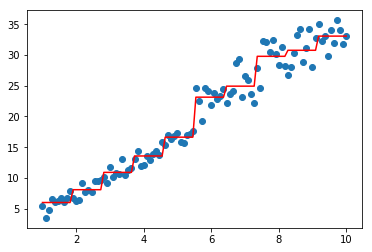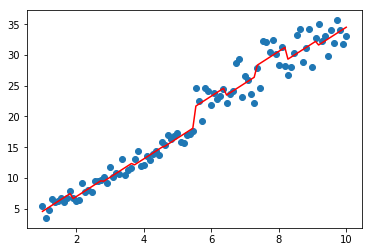一.简介
上一节已经介绍了提升树的算法流程,这一节只需要将下面的优化过程替换成求解具体的梯度即可:
\[w_m^*=arg\min_{w_m}\sum_{i=1}^NL(y_i,f_{m-1}(x_i)+T(x_i,w_m))
\]
下面介绍一下常用的损失函数及其对应的负梯度
(1)损失平方误差:
\[\frac{1}{2}(f_{m-1}(x)-y)^2
\]
对应的负梯度:
\[y-f_{m-1}(x)
\]
(2)绝对误差损失:
\[\mid f_{m-1}(x)-y \mid
\]
对应的负梯度:
\[sign(y-f_{m-1}(x))
\]
(3)Huber损失:
\[\left\{\begin{matrix}
\frac{1}{2}(f_{m-1}(x)-y)^2 & \mid y-f_{m-1}(x) \mid < \delta\\
\delta \mid y-f_{m-1}(x) \mid & otherwise
\end{matrix}\right.
\]
对应的负梯度:
\[\left\{\begin{matrix}
y-f_{m-1}(x) & \mid y-f_{m-1}(x) \mid < \delta\\
\delta\cdot sign(y-f_{m-1}(x)) & otherwise
\end{matrix}\right.
\]
(4)分位数损失:
\[\left\{\begin{matrix}
\theta\mid y-f_{m-1}(x)\mid & y>f_{m-1}(x)\\
(1-\theta)\mid y-f_{m-1}(x)\mid & otherwise
\end{matrix}\right.
\]
对应的负梯度:
\[\left\{\begin{matrix}
\theta & y>f_{m-1}(x)\\
\theta-1 & otherwise
\end{matrix}\right.
\]
注意: \(0<\theta<1\)
这四种损失函数的特点:
(1)平方误差对\(>1\)的错误会进行放大,所以对离群点比较敏感;
(2)而绝对误差可以避免这个问题,但在极小点附近,可能会由于梯度偏大而跨过极小点;
(3)huber损失和分位数损失主要避免异常值的影响
接下来直接进行代码实现
二.代码实现
import os
os.chdir('../')
from ml_models.tree import CARTRegressor
import copy
import numpy as np
import matplotlib.pyplot as plt
%matplotlib inline
"""
梯度提升模型,封装到ml_models.ensemble
"""
class GradientBoostingRegressor(object):
def __init__(self, base_estimator=None, n_estimators=10, learning_rate=1.0, loss='ls', huber_threshold=1e-1,
quantile_threshold=0.5):
"""
:param base_estimator: 基学习器,允许异质;异质的情况下使用列表传入比如[estimator1,estimator2,...,estimator10],这时n_estimators会失效;
同质的情况,单个estimator会被copy成n_estimators份
:param n_estimators: 基学习器迭代数量
:param learning_rate: 学习率,降低后续基学习器的权重,避免过拟合
:param loss:表示损失函数ls表示平方误差,lae表示绝对误差,huber表示huber损失,quantile表示分位数损失
:param huber_threshold:huber损失阈值,只有在loss=huber时生效
:param quantile_threshold损失阈值,只有在loss=quantile时生效
"""
self.base_estimator = base_estimator
self.n_estimators = n_estimators
self.learning_rate = learning_rate
if self.base_estimator is None:
# 默认使用决策树桩
self.base_estimator = CARTRegressor(max_depth=2)
# 同质分类器
if type(base_estimator) != list:
estimator = self.base_estimator
self.base_estimator = [copy.deepcopy(estimator) for _ in range(0, self.n_estimators)]
# 异质分类器
else:
self.n_estimators = len(self.base_estimator)
self.loss = loss
self.huber_threshold = huber_threshold
self.quantile_threshold = quantile_threshold
def _get_gradient(self, y, y_pred):
if self.loss == 'ls':
return y - y_pred
elif self.loss == 'lae':
return (y - y_pred > 0).astype(int) * 2 - 1
elif self.loss == 'huber':
return np.where(np.abs(y - y_pred) > self.huber_threshold,
self.huber_threshold * ((y - y_pred > 0).astype(int) * 2 - 1), y - y_pred)
elif self.loss == "quantile":
return np.where(y - y_pred > 0, self.quantile_threshold, self.quantile_threshold-1)
def fit(self, x, y):
# 拟合第一个模型
self.base_estimator[0].fit(x, y)
y_pred = self.base_estimator[0].predict(x)
new_y = self._get_gradient(y, y_pred)
for index in range(1, self.n_estimators):
self.base_estimator[index].fit(x, new_y)
y_pred += self.base_estimator[index].predict(x) * self.learning_rate
new_y = self._get_gradient(y, y_pred)
def predict(self, x):
return np.sum(
[self.base_estimator[0].predict(x)] +
[self.learning_rate * self.base_estimator[i].predict(x) for i in
range(1, self.n_estimators - 1)] +
[self.base_estimator[self.n_estimators - 1].predict(x)]
, axis=0)
#构造数据
data = np.linspace(1, 10, num=100)
target1 = 3*data[:50] + np.random.random(size=50)*3#添加噪声
target2 = 3*data[50:] + np.random.random(size=50)*10#添加噪声
target=np.concatenate([target1,target2])
data = data.reshape((-1, 1))
#同质
model=GradientBoostingRegressor(base_estimator=CARTRegressor(),n_estimators=3)
model.fit(data,target)
plt.scatter(data, target)
plt.plot(data, model.predict(data), color='r')
[<matplotlib.lines.Line2D at 0x1e76c87fa20>]

#异质
from ml_models.linear_model import LinearRegression
model=GradientBoostingRegressor(base_estimator=[LinearRegression(),CARTRegressor(),CARTRegressor()])
model.fit(data,target)
plt.scatter(data, target)
plt.plot(data, model.predict(data), color='r')
[<matplotlib.lines.Line2D at 0x1e76c87f0b8>]
